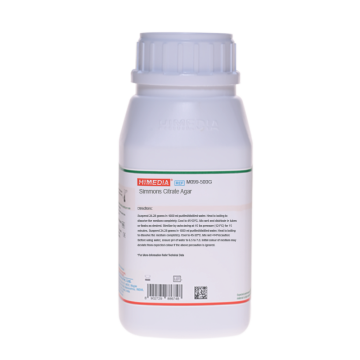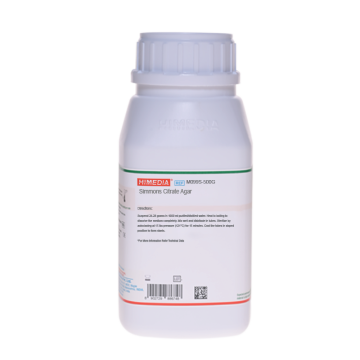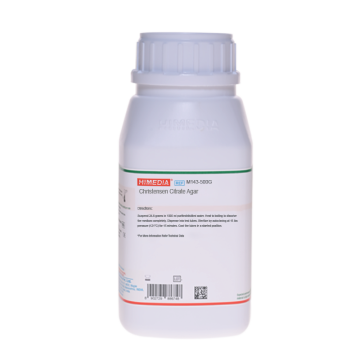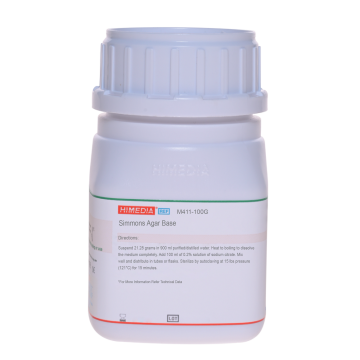 Your enquiry has been submitted
Your enquiry has been submitted
Koser Citrate Medium
Klebsiella species#CC293D
Intended Use
Recommended to differentiate Escherichia coli and Enterobacter aerogenes on the basis of citrate utilization.
Composition**
| Ingredients | g/L |
|---|---|
| Sodium ammonium phosphate | 1.500 |
| Potassium dihydrogen phosphate | 1.000 |
| Magnesium sulphate | 0.200 |
| Sodium citrate | 3.000 |
Final pH (at 25°C): 6.7±0.2
**Formula adjusted, standardized to suit performance parameters
Directions
Suspend 5.7 grams in 1000 ml purified / distilled water. Dispense into tubes and sterilize by autoclaving at 15 lbs pressure (121°C) for 15 minutes. Cool to 45-50°C.
Principle And Interpretation
Coliform bacteria serve as bacterial indicators of sanitary quality of food and water. These bacteria are normally found in the intestinal tract of humans and many warm-blooded animals (1). Coliforms encompasses mostly of Enterobacteriaceae from the genera Enterobacter, Klebsiella, Escherichia, and Citrobacter. The characteristics of the members of Enterobacteriaceae are that they are gram-negative rods and ferment glucose to form acid along with gas production (2). Two important members of the Enterobacteriaceae family are Escherichia coli and Enterobacter aerogenes. Both can be differentiated on the basis of IMViC test. Enterobacter species are able to utilize sodium citrate as the sole carbon source while E.coli fail to do so. This property is used to differentiate the coli-aerogenes group (3). Koser Citrate Medium is used as a base for studying citrate utilization tests. This medium is recommended by APHA, and others, to presumptively identify coliforms encountered in the food and dairy industry (3,4,5,6,7).
The various salts used serve as source of carbon and nitrogen to the organisms. Citric acid or its sodium salt is utilized as a sole source of carbon and ammonium salt as the sole source of nitrogen by E. aerogenes while E. coli does not utilize these salts and hence fail to grow. Koser Citrate Medium may be used in place of Simmon Citrate Agar (M099). Inoculating into Koser Citrate Medium further identifies coli-like colonies from Endo or EMB Agar plates. After 24-48 hours incubation, tubes showing marked turbidity may be assumed to contain organisms from aerogenes group and if the medium remains clear it may be considered as coli. Presumptive positive organisms identified on this medium should be further confirmed by performing the biochemical tests.
Type of specimen
Clinical samples - Isolated organisms from clinical samples; Food and dairy samples; Water samples
Specimen Collection and Handling:
For clinical samples follow appropriate techniques for handling specimens as per established guidelines (8,9).
For food and dairy samples, follow appropriate techniques for sample collection and processing as per guidelines (4,6,10). For water samples, follow appropriate techniques for sample collection, processing as per guidelines and local standards.(11)
After use, contaminated materials must be sterilized by autoclaving before discarding.
Warning and Precautions :
In Vitro diagnostic Use. For professional use only. Read the label before opening the container. Wear protective gloves/ protective clothing/eye protection/ face protection. Follow good microbiological lab practices while handling specimens and culture. Standard precautions as per established guidelines should be followed while handling clinical specimens. Safety guidelines may be referred in individual safety data sheets.
Limitations :
- The pH affects the performance of the medium and must be correctly monitored.
Performance and Evaluation
Performance of the medium is expected when used as per the direction on the label within the expiry period when stored at recommended temperature.
Quality Control
Appearance White to cream homogeneous free flowing powder
Colour and Clarity of prepared medium Colourless, clear solution without any precipitate
Reaction Reaction of 0.57 w/v aqueous solution at 25°C. pH: 6.7±0.2
pH 6.50-6.90
Cultural Response Cultural characteristics observed after an incubation at 35-37°C for 18-24 hours.
| Organism | Growth | Citrate Utilisation |
|---|---|---|
| # Klebsiella aerogenes ATCC 13048 (00175*) | luxuriant | positive reaction, turbidity |
| Enterobacter cloacae ATCC 23355 | luxuriant | positive reaction, turbidity |
| Escherichia coli ATCC 25922 (00013*) | none-poor | negative reaction, no turbidity |
| Klebsiella pneumoniae ATCC 13883 (00097*) | luxuriant | positive reaction, turbidity |
Key: * Corresponding WDCM numbers. # Formerly known as Enterobacter aerogenes
Storage and Shelf Life
Store between 10-30°C in a tightly closed container and the prepared medium at 20-30°C. Use before expiry date on the label. On opening, product should be properly stored dry, after tightly capping the bottle in order to prevent lump formation due to the hygroscopic nature of the product. Improper storage of the product may lead to lump formation. Store in dry ventilated area protected from extremes of temperature and sources of ignition. Seal the container tightly after use. Product performance is best if used within stated expiry period.
Disposal
User must ensure safe disposal by autoclaving and/or incineration of used or unusable preparations of this product. Follow established laboratory procedures in disposing of infectious materials and material that comes into contact with clinical sample must be decontaminated and disposed of in accordance with current laboratory techniques (8,9).
Reference
- Alcamo I. E., 2001, Fundamentals of Microbiology, 6th Edition, Jones and Bartlett Publishers.
- Murray P. R., Baron J. H., Pfaller M. A., Jorgensen J. H. and Yolken R. H., (Ed.), 2003, Manual of Clinical Microbiology, 8th Ed., American Society for Microbiology, Washington, D.C.
- Koser S. A., 1923, J. Bacteriol., 8:493.
- Salfinger Y., and Tortorello M.L., 2015, Compendium of Methods for the Microbiological Examination of Foods, American Public Health Association, Washington, D.C.
- U. S. Food and Drug Administration, 2018, Bacteriological Analytical Manual, AOAC International, Gaithersburg, MD.
- Wehr H. M. and Frank J. H., (Eds.), 2004, Standard Methods for the Microbiological Examination of Dairy Products, MD.
- Williams, (Ed.), 2005, Official Methods of Analysis of the Association of Official Analytical Chemists, 19th Ed., AOAC, Washington, D.C.
- Isenberg, H.D. Clinical Microbiology Procedures Handbook 2nd Edition.
- Jorgensen, J.H., Pfaller, M.A., Carroll, K.C., Funke, G., Landry, M.L., Richter, S.S and Warnock., D.W. (2015) Manual of Clinical Microbiology, 11th Edition. Vol. 1.
- American Public Health Association, Standard Methods for the Examination of Dairy Products, 1978, 14th Ed., Washington D.C.
- Lipps WC, Braun-Howland EB, Baxter TE, eds. Standard methods for the Examination of Water and Wastewater, 24th ed. Washington DC:APHA Press; 2023.
| Product Name | Koser Citrate Medium |
|---|---|
| SKU | M069 |
| Product Type | Regular |
| Physical Form | Powder |
| Origin | Chemically defined (HiCynth™) |
| Packaging type | HDPE |
| References | 1.Alcamo I. E., 2001, Fundamentals of Microbiology, 6th Edition, Jones and Bartlett Publishers. 2.Murray P. R., Baron J. H., Pfaller M. A., Jorgensen J. H. and Yolken R. H., (Ed.), 2003, Manual of Clinical Microbiology,8th Ed., American Society for Microbiology, Washington, D.C. 3.Koser S. A., 1923, J. Bacteriol., 8:493. 4.U. S. Food and Drug Administration, 1995, Bacteriological Analytical Manual, 8th Ed., AOAC International, Gaithersburg,Md. 5.Williams, (Ed.), 2005, Official Methods of Analysis of the Association of Official Analytical Chemists, 19th Ed., AOAC,Washington, D.C. 6.Downes F. P. and Ito K., (Eds.), 2001, Compendium of Methods for the Microbiological Examination of Foods, 4th Ed.,APHA, Washington, D.C. 7.Wehr H. M. and Frank J. H., (Eds.), 2004, Standard Methods for the Microbiological Examination of Dairy Products, 17thEd., APHA Inc., Washington, D.C. |
| Customized Product Available | No |









